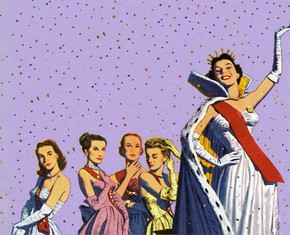The views expressed in our content reflect individual perspectives and do not represent the authoritative views of the Baha'i Faith.
Interestingly, a great deal of fascinating scholarship exists about the neurotic paradigm of romantic love as it has evolved in Western literature and culture.
My favorite is Love in the Western World by Denis de Rougement, which employs a study of the medieval romance as a paradigm for understanding and explaining our contemporary views and beliefs about love, as well as the huri veiled within these beliefs.
According to de Rougement, our modern view of love takes its origin from the medieval romance idea that love thrives only when it is forbidden, or else when its progress is being hindered by insurmountable obstacles, the most frequent one being that the fair maiden is already married to the liege lord of the knight with whom she has fallen helplessly in love.
Thus, an obstacle of some sort is essential if the love is to intensify and remain just out of reach—and in a tenuous condition of stasis beyond any final resolution or union.
RELATED: Love: An Action, Not a Feeling
This is not to say it is beyond consummation, that it is a Platonic relationship as is commonly thought. This is a confusion with Petrarchan love, in which the lover pines for his beloved from a distance, idealizes her, and writes sonnets about her. The only sense in which courtly love is Platonic is that the ecstasy and mystical elements of the intense experience might be thought of as transformative, and can lead to an appreciation of a higher form of love, such as that which Plato describes in The Symposium, or that which Guinevere achieves at the end of Malory’s treatment of the Arthurian legend.
For the most part, however, the courtly love tradition is thoroughly sensual and sexual, with each rendezvous more daring and more intense than the last. It is love from a distance only in the sense that the lovers constantly lament that they are unable to have an unencumbered, long-term, uninterrupted relationship. Of course, what they do not realize—but what de Rougement does—is that the removal of obstacles and the ability to be together daily would quickly destroy the whole shebang. The routine would remove the risk, the intensity, the passion, the longing, and the intermittent ecstasy. They would be stuck with each other all the time and have to worry about earning a living, raising children, cleaning his armor, cooking, taking the kids to sword practice. In time, de Rougement wrote, they would try to find something more passionate on the side:
The myth of falling in love operates wherever passion is dreamed of as an ideal instead of being feared like a malignant fever; imagined as a magnificent and desirable disaster instead of as simply a disaster. It lives upon the lives of people who think that love is their fate (and as unavoidable as the effect of the love-potion in the Romance); that it swoops upon powerless and ravished men and women in order to consume them in a pure flame; or that it is stronger and more real than happiness, society, or morality.
To his great credit, de Rougement does sense that underlying this neurotic myth of ecstatic love is a more profound though unconscious desire, a concealed longing for the most profound transformation of all—death itself, the ultimate transformative experience. Related to de Rougement’s thesis is the fact that an orgasm or post-orgasmic sensation in French (and the courtly love myth is French in origin) is called peu de morts, or “little deaths.” In this sense, the experience of making love might be likened to a preview of the experience of dying. De Rougment also concludes that it is this desire that explains the progress and outcome of all courtly romances—whether Sleeping Beauty, Cinderella, Lancelot and Guinevere, Tristan and Isolde, or Romeo and Juliet.
They all end in one of three ways: they can end “happily ever after,” in which case in our minds they stay forever young, never have children, mortgages, car repairs, or hip replacements. Indeed, the story must immediately stop with their passionate reunion, because otherwise it would go downhill very quickly.
RELATED: Like, Love, and the Highest Form of Love
Consequently, all love stories that have a deliriously happy ending focus on the intensity and complexity of obstacles that must be overcome for the two to get together. Furthermore, the story must ignore all damage that has been done along the way—the post-traumatic shock syndrome that both must necessarily have as a result of enduring countless episodes of tragic experiences. In effect, the ending not only eradicates all obstacles for the love relationship, but we can assume that it also magically cures all emotional scars in the fictional romance that would otherwise complicate a real relationship.
More realistic is the second paradigm often used in the satiric or comic version of this concept in action: the lovers fall out of love by falling in love with someone else, in order to experience once again the same ecstatic experience of new love. Personally, I am fond of referring to this universal serial love cycle as “the Seinfeld syndrome,” a process in which the lover’s life consists of an endless sequence of episodic relationships, all of which hold out the hope of being the “right one,” but none of which ever seem to be exactly what the lover needs, in some cases because of some minuscule flaw in the beloved unobservable to anyone else—she eats her peas one at a time, for example.
This sort of eternal adolescence, so acceptable in contemporary television sitcoms, is not quite so hilarious for the aging lover or for his or her victims left behind, once reconstructive surgeries and innovative chemical assistance no longer function adequately to sustain the inevitable decline in the physical capacity to maintain this neurotic and doomed quest for the perfect fit.
The third possible ending is the tragic conclusion that befits better de Rougement’s thesis that this passion really conceals an ecstatic longing for the ultimate transformative experience of death itself. In this paradigm, things almost work out, but get messed up just in time for the lovers to die or kill themselves, as most forthrightly portrayed in Tristan and Isolde or in Romeo and Juliet.
The paradigm goes something like this. First there is love at first sight, not simply because the lovers are too shallow to be attracted to aught beside physical appearance. But as fate would have it—and in the romance Fate will have it—she is as witty and charming as she is beautiful and, with the appropriate obstacle in place (the family feud), the star-crossed lovers are appropriately doomed. Of course, we excuse the young lovers because they are young, because they are lovers, and besides, people can’t help falling in love. We also forgive Tristan and Isolde their adultery because they have taken a love potion which, when added to the addictive properties of love, means that they are operating outside the laws of free will and thus understandably feel no guilt. Likewise, we also understandably sympathize with all their shenanigans, as they have successive rendezvous and make a complete fool of King Mark, even as Lancelot and Guinevere similarly deceive King Arthur.
In any case, all the lovers in this paradigm kill themselves, and somehow, we are supposed to think this dying-for-love is very exciting and touching. We are even supposed to envy them these intense relationships, which, while usually adulterous and entirely physical, come to epitomize what we ourselves are supposed to discover (only without the death part).
Yet this third category, these unhappy endings, are the romances that endure and tantalize us. We can cheer when Rhett Butler in Gone with the Wind walks out the door after finally realizing what a wretched and selfish woman he has fallen in love with, but we still regret that they couldn’t quite get it together.
RELATED: Love: More than the Media Portrays
However, the Baha’i teachings ask us to consider a fourth alternative—a lasting love based not on serendipity or physical attraction alone, but on the inner spiritual character of the beloved. This kind of relationship, rather than being a fleeting passion, can then become a physical and spiritual union in which the couple not only improve each other’s inner lives, but also create a permanent bond that transcends the physical. It is in this context that Abdu’l-Baha defines Baha’i marriage as:
… the commitment of the two parties one to the other, and their mutual attachment of mind and heart. Each must, however, exercise the utmost care to become thoroughly acquainted with the character of the other, that the binding covenant between them may be a tie that will endure forever. Their purpose must be this: to become loving companions and comrades and at one with each other for time and eternity ….
Few and far between are those love stories where the couple endure hardships, only to find their relationship strengthened, as each learns to assist the other in fashioning a mature and enduring bond, having raised healthy and happy children, and having no regrets about their decision to take willful control of their lives and the progression of their love.
This series of essays is adapted from John Hatcher’s address to the 2005 Association for Baha’i Studies Conference titled The Huri of Love, which comprised the 23rd Hasan M. Balyuzi Memorial Lecture.
















Comments
Sign in or create an account
Continue with Googleor